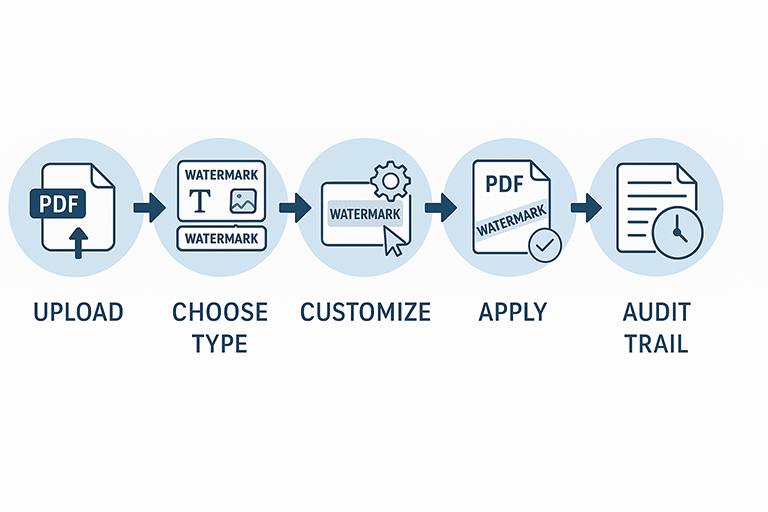Watermarking PDF documents has emerged as a vital aspect of digital document security and management. The importance of watermarking PDF documents cannot be overstated, as it provides a simple yet effective way to protect sensitive information.
Securing business documents is getting tougher as digital files spread faster than ever and leaks seem just one click away. Yet even with all the talk about cloud security and fancy encryption, a simple tactic stands out.
Over 80 percent of organizations now rely on watermarking PDF documents to deter leaks and track origins. That might sound low-tech, but here’s the surprise. Watermarking PDF documents isn’t just about adding a digital stamp. It’s transforming how companies protect their most sensitive files and it could be the missing piece in your document security puzzle.

Table of Contents
- Understanding The Importance Of Watermarking Pdfs
- How To Add Watermarks With Adobe Solutions
- Choosing The Right Watermarking Tools For Enterprises
- Best Practices For Secure Document Workflow Management
Quick Summary
| Takeaway | Explanation |
|---|---|
| Watermarking protects company documents. | It deters unauthorized sharing and tracks document origins effectively. |
| Adobe Acrobat allows easy watermarking. | Users can customize text and images for watermarks, enhancing document security. |
| Advanced techniques enhance document security. | Invisible digital signatures and dynamic watermarks provide robust tracking and protection. |
| Implement access control strategies. | Role-based permissions and multi-factor authentication prevent unauthorized access to sensitive files. |
| Regular monitoring ensures compliance. | Continuous tracking and audits help organizations maintain document security and regulatory alignment. |
Understanding the Importance of Watermarking PDFs
PDF watermarking has become a critical strategy for businesses seeking to protect their confidential documents and maintain intellectual property security. When organizations handle sensitive information, preventing unauthorized distribution and tracking document origins becomes paramount.
The Fundamental Role of Digital Watermarking
In summary, watermarking PDF documents should be a key component of any digital document strategy.
Digital watermarking serves as an invisible yet powerful protective mechanism for PDF documents. According to research from the Rochester Institute of Technology, watermarking is crucial for copyright protection and document authentication. These embedded markers allow organizations to trace document usage, identify potential sources of information leaks, and establish clear ownership.
The process involves strategically inserting unique identifiers or graphics into PDF files that remain detectable even after printing or digital reproduction. These markers can include text, logos, or complex patterns that are not immediately visible but can be revealed through specialized software or forensic analysis.
Security Implications for Business Documents
Research published in the National Institutes of Health’s digital archives highlights that digital watermarking has become a fundamental security measure for protecting business files. By implementing sophisticated watermarking techniques, organizations can:
- Deter Unauthorized Sharing: Watermarks make potential document misuse more risky and traceable.
- Establish Document Provenance: Each watermark can include unique identification details about the document’s origin.
- Create Accountability: In legal and professional contexts, watermarks provide clear evidence of document ownership.
Beyond simple copyright protection, watermarking enables businesses to create comprehensive audit trails. When a confidential document is leaked or misused, watermarks can help trace the source, providing critical forensic evidence.
Here is a summary table outlining the key features and benefits of PDF watermarking for business documents as described above. This can help readers quickly grasp the main reasons to implement watermarking strategies.
| Feature/Benefit | Description |
|---|---|
| Deterrence of Unauthorized Sharing | Watermarks make misuse riskier and trackable. |
| Establishment of Document Provenance | Watermarks include unique origin details. |
| Accountability and Ownership | Provides evidence for legal/professional disputes. |
| Audit Trails | Watermarks help trace leaks back to the source. |
| Visual Watermarking Options | Visible text, logos, or graphics in documents. |
| Invisible/Advanced Watermarking | Digital signatures, dynamic and machine-readable codes. |
| Lifecycle Control | Protection maintained throughout document’s lifetime. |
Advanced Watermarking Strategies
Modern watermarking goes far beyond simple visual overlays. Advanced techniques include invisible digital signatures, dynamic watermarks that change based on document interactions, and machine-readable embedded codes. These sophisticated approaches allow for granular tracking and protection of sensitive information.
Businesses across various sectors are recognizing that document security is not just about preventing initial unauthorized access but also about maintaining control and visibility throughout a document’s lifecycle. Learn more about protecting your business documents with advanced PDF solutions.
By integrating robust watermarking strategies, organizations can significantly reduce the risks associated with document theft, unauthorized sharing, and potential intellectual property compromises. The investment in these technologies represents a proactive approach to information security in an increasingly digital business environment.
How to Add Watermarks with Adobe Solutions
Adobe Acrobat provides robust tools for adding watermarks to PDF documents, enabling businesses to secure and track their digital files with precision and ease. Understanding the process of implementing watermarks can help organizations protect their intellectual property and maintain document integrity.
Understanding how watermarking PDF documents works is crucial for effective digital asset management.
Configuring Basic Watermark Settings
According to Southern Illinois University Edwardsville’s technical documentation, adding watermarks in Adobe Acrobat involves several straightforward steps. Users can access the watermark feature through the ‘Edit PDF’ tool, which allows for comprehensive customization of document protection.
To begin, navigate to the ‘Tools’ panel and select ‘Edit PDF’. From the available options, choose ‘Watermark’ and then ‘Add’. This opens a configuration interface where users can define multiple critical parameters:
Below is a table summarizing the main steps involved in adding a watermark using Adobe Acrobat, based directly on the detailed instructions in the article. This process table helps clarify the workflow for users new to watermarking in Adobe.
| Step | Action | Description/Options |
|---|---|---|
| 1 | Open ‘Tools’ → ‘Edit PDF’ | Access the primary document editing interface. |
| 2 | Select ‘Watermark’ → ‘Add’ | Initiate the watermark configuration process. |
| 3 | Choose Watermark Type | Select between text or image watermark. |
| 4 | Customize Settings | Adjust text content, images, opacity, positioning as required. |
| 5 | Preview & Apply | Review watermark placement, then confirm application to selected pages/ranges. |
Many businesses now utilize watermarking PDF documents to ensure their files are protected from unauthorized sharing.
- Text Watermarks: Create custom text messages that can include company names, confidentiality notices, or tracking information.
- Image Watermarks: Upload logos or graphics to serve as unique identifiers.
- Opacity Control: Adjust transparency to ensure watermarks are visible without obscuring document content.
- Positioning: Precisely place watermarks on specific document locations.
Advanced Watermarking Techniques
By focusing on incorporating watermarking PDF documents effectively, organizations can enhance their overall security posture.
Professional watermarking goes beyond simple visual overlays. Advanced Adobe Acrobat features allow for dynamic and intelligent watermark applications. Users can:
Employing watermarking PDF documents as part of your strategy can significantly deter unauthorized access.
For companies focused on security, watermarking PDF documents should be at the forefront of their document management strategy.
- Set different watermarks for individual page ranges
- Create preset watermark configurations for consistent document handling
- Apply watermarks diagonally or at specific rotational angles
- Automatically timestamp documents with watermark information
Explore our advanced Adobe Acrobat plugin solutions for enhanced PDF management.
Workflow Integration and Best Practices
Successful watermarking requires strategic implementation. Businesses should develop clear protocols for watermark usage, ensuring consistent application across departments. Key considerations include:
The implementation of watermarking PDF documents will ensure that organizations can maintain the confidentiality of their data.
Watermarking PDF documents adds an essential layer of security in a digital landscape where information leaks are prevalent.
- Standardizing watermark design to reflect organizational branding
- Training employees on proper watermark application
- Implementing automated watermarking for batch document processing
- Regularly updating watermark templates to maintain security
You can achieve your document security goals by implementing watermarking PDF documents effectively across your organization.
By leveraging Adobe Acrobat’s comprehensive watermarking tools, organizations can create a robust defense against unauthorized document sharing while maintaining professional document presentation. The ability to customize, automate, and track watermarks transforms document security from a reactive measure to a proactive strategy.
Choosing the Right Watermarking Tools for Enterprises
Enterprises require sophisticated PDF watermarking solutions that balance security, usability, and comprehensive document management. Selecting the appropriate tools demands a strategic approach that considers multiple factors beyond basic document protection.
Security and Compliance Considerations
Implementing comprehensive watermarking PDF documents strategies ensures that businesses can protect their most vital files.
According to the PDF Association, effective document security encompasses multiple layers of protection. Watermarking represents just one component of a comprehensive digital security strategy. When evaluating tools, organizations must assess capabilities that extend beyond simple visual markers.
Key enterprise-level requirements include:
- Scalability: Tools must handle large document volumes efficiently
- Customization: Ability to create complex, organization-specific watermarks
- Integration: Seamless compatibility with existing document management systems
- Audit Tracking: Comprehensive logging of watermark applications and modifications
Advanced Technical Evaluation Criteria
Overall, watermarking PDF documents is a critical component of any effective document management system.
The U.S. Department of Energy’s guidelines highlight the importance of selecting tools that support multiple security dimensions. Enterprise watermarking solutions should offer:
- Invisible digital signatures
- Dynamic watermark generation
- Metadata embedding
- Compliance with industry-standard security protocols
Watermarking PDF documents offers a multifaceted approach to securing digital content effectively.
Learn more about advanced PDF metadata management for enterprise solutions.
Long-Term Preservation and Accessibility
The National Archives and Records Administration emphasizes the critical need for watermarking tools that maintain document integrity during long-term preservation. Enterprise solutions must ensure:
- Font embedding to preserve formatting
- Compatibility with archival standards
- Ability to deactivate security settings without compromising document authenticity
- Support for cross-platform document accessibility
Enterprise-grade watermarking transcends simple visual protection. The ideal solution provides a comprehensive approach to document security that adapts to evolving technological landscapes while maintaining strict compliance with organizational and regulatory requirements. By carefully evaluating tools across technical, operational, and strategic dimensions, businesses can implement robust watermarking strategies that protect intellectual property and maintain document credibility.
Best Practices for Secure Document Workflow Management
Secure document workflow management represents a critical component of modern business operations, requiring strategic approaches that protect sensitive information while maintaining operational efficiency. Organizations must develop comprehensive strategies that address document security from multiple perspectives.
Authentication and Access Control
According to TechSoup’s security recommendations, implementing robust authentication mechanisms is fundamental to protecting digital assets. Multi-factor authentication (MFA) and single sign-on (SSO) tools provide crucial layers of security that prevent unauthorized document access.
Key strategies for effective access management include:
- Role-Based Access: Limit document visibility based on employee roles
- Granular Permissions: Configure precise read, write, and share permissions
- Active Directory Integration: Synchronize access controls with organizational user management systems
- Regular Access Audits: Continuously review and update user permissions
Document Classification and Metadata Management
The U.S. Department of Energy’s guidelines emphasize the importance of comprehensive document metadata and classification. Effective workflows require systematic approaches to document identification and tracking:
- Implement consistent tagging strategies
- Embed metadata for enhanced searchability
- Create clear document classification hierarchies
- Automate metadata extraction and validation processes
Explore advanced document version control strategies for modern businesses.
Continuous Monitoring and Compliance
The PDF Association highlights the critical nature of ongoing document security monitoring. Organizations must develop proactive approaches to tracking document lifecycles and potential security risks.
To effectively manage document security, organizations must consider how watermarking PDF documents fits into their overall strategy.
Comprehensive monitoring strategies should include:
- Real-time document access logging
- Automated alerts for suspicious document activities
- Regular security vulnerability assessments
- Compliance tracking with industry-specific regulations
Successful document workflow management transcends technical implementations. It requires a holistic approach that combines technological solutions, employee training, and adaptive security protocols. By integrating advanced authentication methods, intelligent document classification, and continuous monitoring, businesses can create resilient document management ecosystems that protect sensitive information while enabling efficient collaboration and information sharing.
Frequently Asked Questions
What is the purpose of watermarking PDF documents?
Watermarking PDF documents serves to protect sensitive information by deterring unauthorized sharing and establishing accountability through traceable identifiers embedded in the document.
How can I add a watermark to my PDF using Adobe Acrobat?
To add a watermark in Adobe Acrobat, navigate to ‘Tools’ → ‘Edit PDF’, select ‘Watermark’ → ‘Add’, and customize your watermark settings including text, images, opacity, and positioning before applying it to your document.
What are the benefits of using advanced watermarking techniques for PDFs?
Advanced watermarking techniques, such as invisible digital signatures and dynamic watermarks, provide enhanced security by allowing for granular tracking and protection, ensuring document integrity throughout its lifecycle.
How do watermarking tools impact document security in enterprises?
Watermarking tools enhance document security in enterprises by allowing for the creation of comprehensive audit trails, thus deterring unauthorized sharing and providing clear evidence of document ownership and provenance.
Take Control of PDF Security and Workflow with Mapsoft Solutions
To conclude, watermarking PDF documents plays a fundamental role in the ongoing battle against information leaks.
Are you struggling to keep business documents secure even after watermarking, as described in this article? If you want greater control over who accesses your files, need to automate watermarking across hundreds of documents, or worry about maintaining compliance, you are not alone. Many companies face frustration when manual tools fall short and tracking or batch-processing becomes a costly bottleneck.

Your solution is here. Mapsoft specializes in advanced PDF management designed to seamlessly handle watermarking, batch processing, and robust security. With Mapsoft PDF Hub you get the power to automate watermarking, control access, manage metadata, and ensure full traceability of your sensitive files. Visit Mapsoft.com to discover how to secure your workflows, unlock customizable plugins for Adobe Acrobat, or learn more about our enterprise document handling expertise. Your confidential documents deserve better protection—act now to give your business peace of mind.
Utilizing advanced technology can enhance the effectiveness of watermarking PDF documents in protecting sensitive data.
Recommended
Ultimately, the effective use of watermarking PDF documents will result in enhanced security measures for all organizations.
Therefore, watermarking PDF documents should be a top priority for organizations aiming to mitigate risks related to information leaks.
In essence, watermarking PDF documents is vital for preventing document-related security breaches.
Therefore, organizations must embrace watermarking PDF documents as a fundamental aspect of their security framework.
Thus, organizations that utilize watermarking PDF documents effectively will have a strong security posture.
Therefore, companies must prioritize watermarking PDF documents as part of their risk management strategies.
Conclusively, watermarking PDF documents is essential in today’s digital environment for protecting sensitive data.
Therefore, it is imperative that organizations prioritize watermarking PDF documents as part of their security measures.
Thus, watermarking PDF documents will be crucial for organizations focused on safeguarding their digital assets.
Ultimately, effective watermarking PDF documents implementation can empower organizations to maintain document integrity and confidentiality.
Investing in watermarking PDF documents is a proactive step towards safeguarding sensitive business information.
In conclusion, organizations that prioritize watermarking PDF documents will be better prepared to address digital security challenges.
By taking advantage of watermarking PDF documents, organizations can protect their sensitive information from various risks.
- Unlock the Benefits: Why Use PDF Format for Business
- Editing PDF Metadata for Unlocking Success Tips
- Document Version Control for Businesses in 2025: Best Practices and Adobe Solutions – Mapsoft
- The Best PDF Redaction Tools for Privacy and Security
Conclusion
- Watermarking PDF documents allows businesses to maintain control over their confidential information.
- Organizations should embrace watermarking PDF documents not just as a security measure but as a strategic advantage.
- Implementing watermarking PDF documents can deter information leaks and enhance document accountability.
- Many organizations find that watermarking PDF documents is essential in their efforts to secure intellectual property.
- The future of document management relies on effective watermarking PDF documents strategies that secure sensitive information.
- In conclusion, watermarking PDF documents is a critical aspect of safeguarding sensitive information in today’s digital landscape.
- Watermarking PDF documents should not be viewed as an afterthought but as an integral part of document management.
- Ultimately, the success of watermarking PDF documents relies on strategic implementation and ongoing management.
- The strategic use of watermarking PDF documents can help safeguard sensitive information from potential threats.
- To summarize, watermarking PDF documents is essential for ensuring the security of sensitive business information.
- The incorporation of watermarking PDF documents into business practices can lead to a more secure operating environment.
- Embracing watermarking PDF documents technologies is critical for organizations seeking to maintain document integrity.
- Organizations that prioritize watermarking PDF documents will find themselves better equipped to handle security challenges.
- By ensuring that watermarking PDF documents is prioritized, organizations can better protect their intellectual property.
- Ultimately, watermarking PDF documents is vital for achieving comprehensive digital security and document integrity.
- Organizations that embrace watermarking PDF documents can better navigate the complexities of digital security.
- The ability to implement watermarking PDF documents effectively can transform how organizations manage and protect their data.
- In conclusion, effective watermarking PDF documents strategies will empower organizations to secure their digital assets.
- Thus, watermarking PDF documents is essential for organizations aiming to enhance their overall security measures.
- Ultimately, successful watermarking PDF documents implementation leads to a more secure business environment.
- In summary, watermarking PDF documents is a fundamental practice for any business committed to protecting sensitive data.
- By focusing on watermarking PDF documents, organizations can ensure greater protection for their confidential information.
- Thus, watermarking PDF documents should be integral to any comprehensive document management policy.
- In summary, watermarking PDF documents is an essential strategy for any organization looking to enhance their security framework.
- Therefore, prioritizing watermarking PDF documents is essential for ensuring the long-term protection of sensitive information.
- Therefore, organizations should consider watermarking PDF documents as a key component of their security strategy.
- In summary, organizations that effectively utilize watermarking PDF documents can protect their sensitive data more efficiently.
- In conclusion, the practice of watermarking PDF documents is essential for any organization dedicated to data protection.
- In conclusion, the strategic application of watermarking PDF documents is crucial for securing confidential information.
- Ultimately, organizations can improve their digital security landscape by prioritizing watermarking PDF documents.
- Organizations embracing watermarking PDF documents will stand a better chance at preventing unauthorized access.
- To summarize, watermarking PDF documents can effectively safeguard valuable corporate information.
- In summary, watermarking PDF documents is a fundamental strategy for protecting sensitive information.
- In conclusion, watermarking PDF documents is critical for maintaining confidentiality and integrity in business operations.
- As a result, companies will be better equipped to handle challenges associated with unauthorized access.
- To conclude, watermarking PDF documents should be integral to any organization’s document security policy.
- In summary, watermarking PDF documents is a key practice that can enhance security across various sectors.


